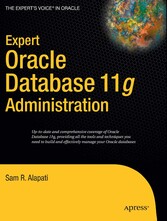Search and Find
Service
CHAPTER 5 Oracle Database 11g Architecture (S. 165-166)
¦ ¦ ¦
In the first four chapters, I set the stage for working with Oracle. It’s time now to learn about the fundamental structures of Oracle Database 11g. Oracle uses a set of logical structures called data blocks, extents, segments, and tablespaces as its building blocks. Oracle’s physical database structure consists of datafiles and related files. Oracle memory structures and a set of database processes constitute the Oracle instance, and are responsible for actually performing all the work for you in the database.
To understand how the Oracle database works, you need to understand several concepts, including transaction processing, backup and recovery, undo and redo data, the optimization of SQL queries, and the importance of the data dictionary. This chapter provides an outline of the important Oracle automatic management features, as well as the sophisticated built-in performance tuning features, including the Automatic Workload Repository (AWR) and the Automatic Database Diagnostic Monitor (ADDM), a brand new diagnostic framework introduced in this release, and the new Data Recovery Advisor, which helps you easily recover from several types of data disasters and errors. I also outline Oracle’s advisor-based Management Framework.
Oracle Database Structures
In discussing the Oracle database architecture, you can make a distinction between the physical and logical structures. You don’t take all the data from the tables of an Oracle database and just put it on disk somewhere on the operating system storage system. Oracle uses a sophisticated logical view of the internal database structures that helps in storing and managing data properly in the physical datafiles.
By organizing space into logical structures and assigning these logical entities to users of the database, Oracle databases logically separate the database users (who own the database objects, such as tables) from the physical manifestations of the database (datafiles and so forth). The following sections discuss the various logical and physical data structures.
Logical Database Structures
Oracle databases use a set of logical database storage structures in order to manage the physical storage that is allocated in the form of operating system files. These logical structures, which primarily include tablespaces, segments, extents, and blocks, allow Oracle to control the use of the physical space allocated to the Oracle database.
Taken together, a set of related logical objects in a database is called a schema. Remember that Oracle database objects, such as tables, indexes, and packaged SQL code, are actually logical entities. Dividing a database’s objects among various schemas promotes ease of management and a higher level of security. Let’s look at the logical composition of an Oracle database from the bottom up, starting with the smallest logical components and moving up to the largest entities:
• Data blocks: A data block is the smallest building block of the Oracle database and consists of a specific number of bytes on the disk.
• Extents: An extent is two or more consecutive Oracle data blocks, and this is the unit of space allocation.
• Segments: A segment is a set of extents that you allocate to a logical structure like a table or an index (or some other object).
• Tablespaces: A tablespace is a set of one or more datafiles, and usually consists of related segments.
The datafiles contain the data of all the logical structures that are part of a tablespace, like tables and indexes. The following sections explore each of these logical database structures in detail.
All prices incl. VAT













